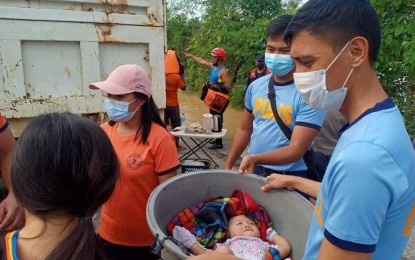
TO THE RESCUE. A baby is among those rescued by police personnel in Barangay Linao Norte, Tuguegarao City, Cagayan on Friday (Nov. 13, 2020) after Typhoon Ulysses caused massive floods in the province. The DILG said some 3,267 police and fire personnel were deployed to conduct search and rescue operations in flood-hit areas in Cagayan Valley. (Photo courtesy of Tuguegarao City PNP)
MANILA – The Department of the Interior and Local Government (DILG) has deployed some 3,267 police and fire personnel to Cagayan and Isabela provinces for search and rescue and disaster response operations, in coordination with the Coast Guard, the military, and rescue teams of local government units (LGUs).
Interior Secretary Eduardo Año said in a news release on Saturday the figure consists of 1,087 police personnel in various LGUs and 920 police officers of the Reactionary Standby Support Force of Police Regional Office (PRO) 2 (Cagayan Valley) based in Tuguegarao City.
Some 1,260 Bureau of Fire Protection (BFP) personnel deployed, along with 28 Emergency Medical Service and Special Rescue Unit personnel, he said, adding that reserve contingents from other police and fire regional offices and national headquarters have also been mustered for rapid deployment.
Cagayan’s provincial government said a total of 156 barangays in 24 out of 29 areas in the province were flooded due to the onslaught of Typhoon Ulysses.
Meanwhile, he also commended the Philippine National Police (PNP) and the BFP for a job well done in working closely with the LGUs in rescuing and evacuating some 163,532 families in “Ulysses”-affected areas in other parts of the country.
Año said some 363 rescue teams composed of about 25,000 PNP officers and 10,147 BFP personnel were dispatched to all regions in Luzon, including the National Capital Region (NCR), to aid affected families and individuals.
“I commend our police and fire officers for their selfless and heroic acts of braving the floodwaters, doing search and rescue missing, monitoring landline-prone areas, and keeping evacuation centers orderly amid the onslaught of Typhoon Ulysses. They did a good job in NCR and other regions, now they are doing it in Cagayan,” he said.
Año said the men and women of the LGUs, BFP, and PNP have risked their lives to fulfill their sworn duties.
“Their deeds don’t usually make it to the media but their acts are testaments that they are working and caring for the people,” he added.
In a report to the DILG, the PNP rescued and evacuated some 104,850 individuals while the BFP rescued and assisted 58,682 individuals.
This was possible because the PNP and BFP personnel were already on red alert as early as November 11.
Año explained that the local chief executives are the ones on top of the disaster risk reduction (DRR) initiatives in their respective areas of jurisdictions.
Their local DRR teams composed of police, fire, and other personnel are automatically activated once a typhoon alert is issued by the weather bureau.
“Ilang taon na rin simula ng pinapatupad ng DILG ang Operation Listo at ang lahat ng mga LGUs ay automatic na gumagawa ng critical preparedness measures tatlong araw bago pa man mananalasa ang bagyo (The DILG has been implementing Operation Listo for years and all LGUs automatically undertake critical preparedness measures three days before the onslaught of the typhoon),” Año said.
He said police and fire officers were already deployed to help the LGUs implement preemptive evacuation ahead of the typhoon’s landfall.
The PNP also secured some 13,526 evacuation centers while the BFP monitored 1,861 evacuation centers across the country.
Part of the deployed police equipment to various Ulysses-affected areas were rubber boats and trucks while the deployed fire equipment include fire trucks, rescue/hazmat trucks, and ambulances.
“Hindi man natin maiwasan ang hagupit ng hangin at ulan sa tuwing may malakas na bagyo pero malaking tulong ang kahandaan ng ating mga LGUs, kapulisan, at bumbero kaya mas mababa ang nasawi nitong bagyong Ulysses kumpara sa mga nagdaang bagyo (We cannot avoid the gusty winds and heavy rains whenever there is a strong typhoon but the preparedness of our LGUs, police and firefighters contributed to the low casualties incurred from Typhoon Ulysses as compared to the past typhoons),” he added.
Lift strict health protocols for relief, rescue ops
Meanwhile, the DILG has directed Cagayan’s provincial government to lift its strict coronavirus disease 2019 (Covid-19) health protocols to allow relief, search and rescue teams, and for media outlets to have immediate access to areas affected by “Ulysses”.
Año said they have received numerous reports that relief and media organizations were barred at the provincial border because of strict quarantine restrictions imposed by the provincial government.
“The situation in Cagayan requires unhampered disaster response and recovery operations by rescue and relief organizations. Therefore, all LGUs in Cagayan and Isabela should ease up access in their areas to facilitate disaster operations,” he said. “Existing LGU requirements related to the management of the Covid-19 pandemic should not hamper nor delay the entry, passage, or operations of all government and private sector humanitarian assistance and response personnel.”
Año directed the regional task force on Covid-19 and all LGUs to exercise sound discretion in lifting the restrictions.
He, nonetheless, directed all disaster response personnel and media workers to observe minimum health standards and use face masks and face shields while doing their humanitarian work.
“The mayors know best the situation in their areas, so they should use their sound discretion in lifting the restrictions but always implement the minimum health standards in the conduct of relief operations,” he added. (PR)
